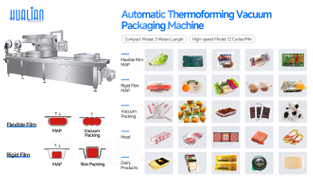Top 5 Thermoforming Packaging Machine Manufacturers WorldwideLooking for the top thermoforming packaging machine manufacturers worldwide? We understand that the search can be a hassle. This is why we’ve listed the top 5 thermoforming packaging machine manufacturers you can trust. Let’s dive right in
Top 10 Advantages of RTE Packaging for Consumers and ManufacturersThere is an ongoing demand for Ready-to-Eat (RTE) food, and this is influenced by consumers’ need for convenience, freshness, and trust in the products they buy. If you’re a manufacturer, then you’re also concerned about how to mainta
Seafood Packaging: Key Technologies for Freshness and Extended Shelf LifeSeafood is one of the most delicate foods in the market. It is important to preserve freshness and shelf life to increase quality, safety, and customer satisfaction. As a seafood processing company, no doubt, you’re looking for
Sausage is a type of meat product and an indispensable ingredient in many dishes. Due to its unique form, it attracts more and more buyers. Sausage packaging needs to pay attention to hygiene, protection, and aesthetic appeal to enhance its attractiveness on the shelves.



